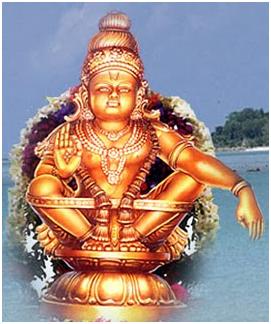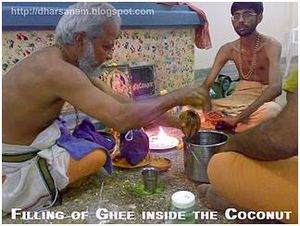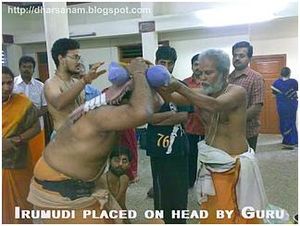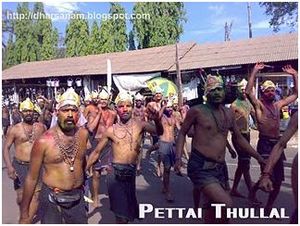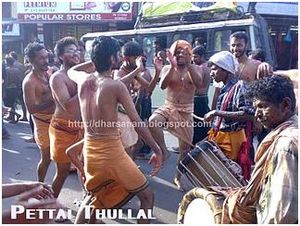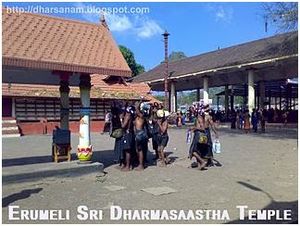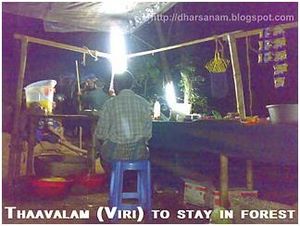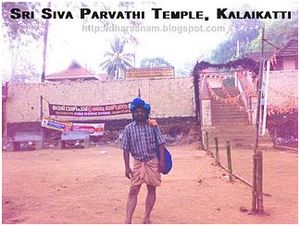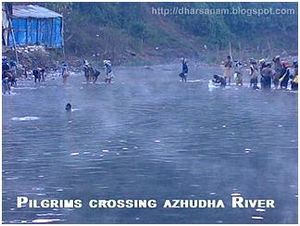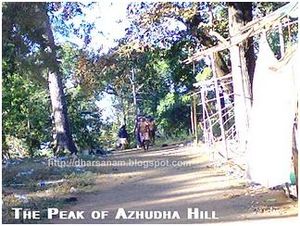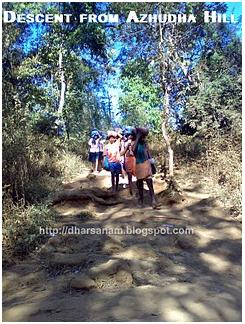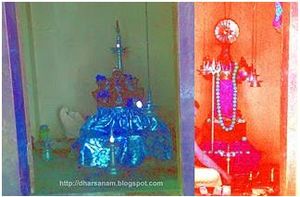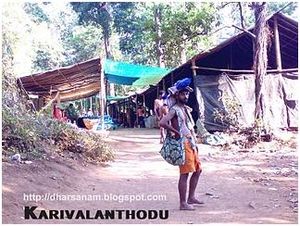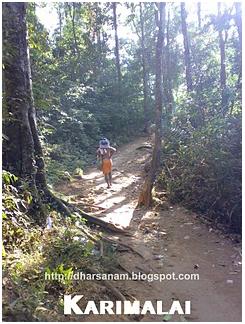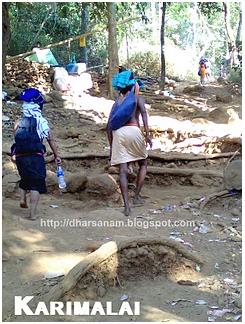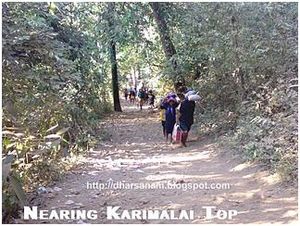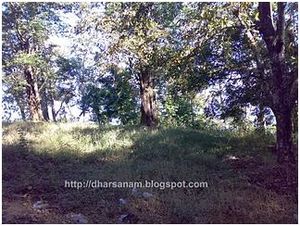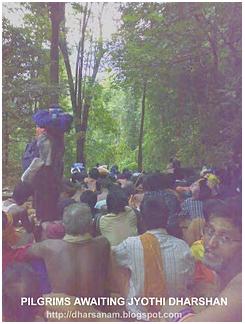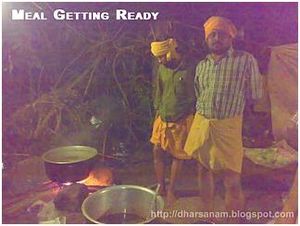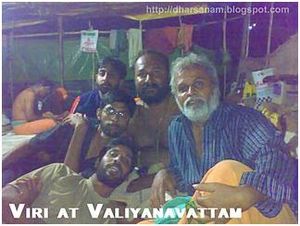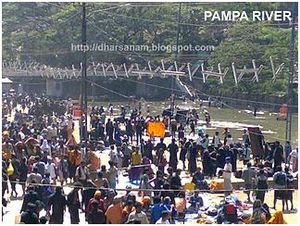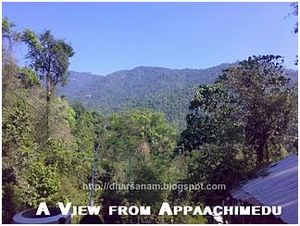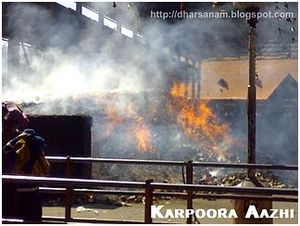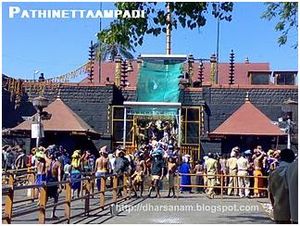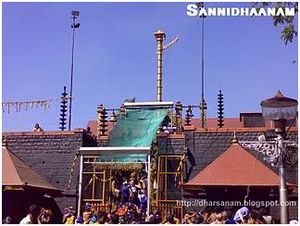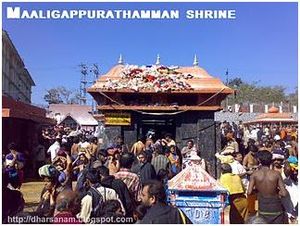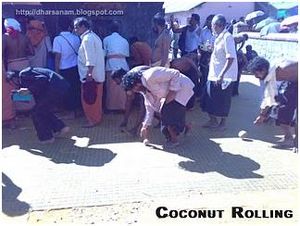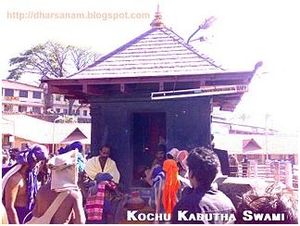Sabarimalai Peruvazhi
The pilgrimage to Sabarimalai starts after severe Viratham (fast) for about 41 days. On the day of departure, pilgrims have the ritual of “Irumudi Kattu” or “Kattu Nirai” in which they accept the Irumudi (a bag with 2 portions) from their Guru. The front portion of the Irumudi consists of the ghee filled inside a 3 eyed coconut. The back portion contains eatables or provisions for consumption during the rigorous trek.
Pilgrims with much devotion carry the Irumudi received from their Guru and leave their homes. While leaving their home, pilgrims neither even bid good bye to their folks nor look back, as it’s believed that once started to Sabarimalai they are in the hands of the Lord Himself. So, one can’t inform his folks that he would be back. They are at the discretion of the Lord which depends on the sincerity of their devotion to God. In Sabarimala pilgrimage, Guru is the supreme of all and pilgrims strictly follow their Guruswamy's instructions throughout their fasting till they reach back home.
The traditional route to Sabarimala by walk starts at Erumeli. This place got its name from Mahishi who was in the form of Eruma (bull), killed by Lord Ayyappan in this forest. Erumeli can be reached by road from Chengannur or Kottayam, which are well connected by trains.
Pilgrims after reaching Erumeli perform a traditional ritual called Pettai Thullal. Pettai means area and Thullal means Dance. Pilgrims disguise themselves like tribes, with leaves tied on their head applying color powders all over. Dummy weapons like Swords, Bows etc, are carried on their shoulders. They also hire music accompaniments like Dhavil or Chenda Melam and Nadhaswaram with them, chant “Swami Thinthakkathom – Ayyappa Thinthakkathom” and dance along the way for about half a kilometer stretch.
This is celebrated to mark the victory of Lord Ayyappan over Mahishi. Also this enables the pilgrims to give up their ego and realize that everyone is the equal in front of Lord Ayyappan. After this, pilgrims take bath in the nearby pond; get fresh and all set for the Peruvazhi trek. A refreshing bath in cold waters after a tiring dance makes one energetic and prepared for the rigorous walk. There is a Dharma Saastha temple at Erumeli. Pilgrims gather here at, worship Saastha and then proceed to walk with Irumudi on their head.
From here, pilgrims also visit the Vavar’s Shrine (Mosque) located nearby and worship him before proceeding. In Vavar’s Shrine, Vibhuthi (holy Ash) is given as Prasaadham to devotees.
The Peruvazhi to the temple starts here. A lengthy walk in the forests through night and day on barefoot is a wonderful experience. There are ample refreshment stalls and Thaavalams (called Viri) to stay along the path inside the forest. But don’t expect a great refreshment center there. It’s just a petty shop with PU sheets as the roof and the same sheets on the floor to sit or sleep. You get Lime juice (Naaringa Vellam in Malayalam), Pine apple slices etc., to quench your thirst during the day walk. In the nights or early mornings, you get black tea (Kadunchaaya) or black coffee (Kadunkaapi) made with the available resources. The shop owners bring materials and food stuff along with crockery, by jeep to some extent and on donkeys to the interior forest. Most of the eatables are expensive as the labor charges to bring it inside the forest are tagged to them.
Parathas and Rice Kanji (porridge) with pickles are available for breakfast or lunch. Don’t expect great hygiene. After all you get something to eat in such a dense forest. Also after a strenuous trek for hours, whatever you eat gets digested, is more important. Moreover, the lighter you eat, the better you walk.
There is a proper road for up to about 3-4 kms from the starting point with many rubber estates around. After a walk of about 4 kms on plains, there is a place called Perur Thodu (Thodu means stream) where there is a small stream of a river passing by. It is believed that Lord Ayyappa rested here, on his way to Sabarimala. Pilgrims offer Pori (rice flakes) to the fishes here.
Lord Ayyappan’s Poongavanam (Garden) starts from this place. From here one has to walk through many small ups and downs on the hill range. Next important point is called Kaalai Katti, which is about 10 kms from here. It’s the place where Lord Shiva came with Parvathi Devi, tied his Kaalai (Rishaba Vaahana or Ox in English) and witnessed Lord Ayyappan defeating Mahishi. As he tied his Kaalai (His carrier) here, the place came to be known as Kaalai Katti.
There are many Thaavalams here to eat and stay. From here, when you walk down for about 2 kms, there flows the sacred river Azhudha. Pilgrims also stay on the banks of Azhudha, as they can bathe in the river before proceeding. Pilgrims also carry a pebble from this river to be offered at Kallidum Kunru. Azhudha hill starts from here. Azhudha hill is steeper to climb. Pilgrims move upwards, resting often to take a breath. After walking up the hill, one will reach Kallidum Kunru. Pilgrims throw the stone which they picked up from Azhudha River to mark the defeat of Mahishi, as Lord Ayyappan threw huge stones on Mahishi after defeating her, to ensure that she doesn’t come up again.
From here, after another steep climb comes the Azhudha Uchi (peak) which is called Injipparakkotta or Udumbara Mala. There is a small Ayyappan temple here. Also there is another small shrine for Udumbara (a forest God). This is the peak of Azhudha hills where devotees offer worship lighting camphor. Also Vedi Vazhipaadu is done here, in which crackers are burnt in the name of the devotee. This tradition is followed in many places along the way because the noise of the crackers would keep wild animals away. One has to descend from here to reach a place called Mukkuzhi. There are many Thaavalams (sheds) in Mukkuzhi to rest and to eat. There are small shrines for Sri Ganapathi and Sri Bagavathi here.
After descending further from Mukkuzhi, one will reach a valley like place where a stream of water passes by. This is the foot hill of Karimalai. The stream flows with Azhudha hill on one side and Karimalai on other side. Many elephants from the forest come here to quench their thirst. This place is called Karivalanthodu (Karivalam Thodu). Kari means elephant, Valam means wander, Thodu means stream of water.
Next starts a lengthy trek on Karimalai, which is the most difficult part of the trek. Many elephants live in this hill and hence it is called Karimalai. Karimalai has about seven levels to cross before reaching the peak. It takes hours to climb up the whole hill to reach atop. The mound near the peak is too steep to climb, where pilgrims constantly chant the name of the Lord to reach the top.
There are many Thaavalams on the top for resting. Pilgrims rest here before proceeding. There are shrines for Sri Karimalanathar, Sri Kochu Kadutha Swamy and Sri Karimala Bagavathy here. Pilgrims worship these deities before proceeding. It is believed that these Gods don’t allow pilgrims beyond this place, who didn’t properly follow the austerities during their Viratham (fast). The holy river Pampa is about 5 kms from here.
After this peak, the descend starts which is more strenuous with rocks and huge trees hurdling the path. After about 3 kms comes Valiyanavattam or Periyanavattam. One will get a good sight of Makara Jyothi from here too. There are many Viris to stay here. After walking another kilometer, comes Siriyanavattam. Many pilgrims prefer to stay at Periyanavattam or Siriyanavattam as Pampa is too crowded. After descending about a km, one can reach the holy Pampa River on the banks of which Lord Ayyappa was found.
Pilgrims take out the provisions etc, carried on the back portion of their Irumudi and prepare food here. They also feed many other fellow pilgrims. In the Ayyappa cult, Annadhaanam (free feeding) is an important tradition. One can witness Annadhaanam at various places in Pampa. Cooking and feeding the food here is called Pampa Sadhya (Pampa feast).
The first timers to Sabarimala (called Kanni Swamis) go from place to place to collect the ashes from the fire on which the meal is cooked for Annadhaanam. They go from Viri to Viri to collect as much ash possible and this ash is distributed as Prasaadham and also taken back home. It is believed that wherever Annadhaanam is happening, Lord Ayyappan joins a place to eat or feed the pilgrims. Since, one don’t know in which Viri he was present, they collect as much ash possible from various Viris to be taken as Prasaadham.
During the sunset, pilgrims prepare decorated lamps in various shapes made out of bamboo from the forest. They carry it from their Viri up to River Pampa and make it float on Pampa. This is called Pampa Vilakku. It’s a feast to watch so many such lamps floating on the river in the night. Pilgrims also perform Pithru Tharpanams (annual rites) to their ancestors at the banks of River Pampa, as Pampa is considered equivalent to River Ganga.
After the traditional rituals at Pampa pilgrims again start their treck further towards Sabarimala. Pilgrims, who choose to take the shorter route (Chinna Paadhai), reach by road till here. From here Sannidhaanam is located at about 6 kms. After crossing Pampa River one has to climb up to visit Kanni Moola Ganapathi temple, which is the first point from here. The main deity here is Sri Pampa Ganapathy or Kanni Moola Ganapathi. Pilgrims break coconut in this temple as a mark of their arrival. Other deities present in the temple are Sri Rama and Sri Anjaneyar.
After crossing this temple there is a small shrine like place meant for Pandala Raja (King of Pandalam). According to legend, as Lord Ayyappan comes from the Pandala dynasty, whoever visits the Lord has to obtain permission from the king or his representative here. Vibhuthi (Ash) is given as Prasaadham here by the Pandala Raja’s representatives. This is the foot hill of Neelimalai. From here the Neelimalai starts. It is much steeper than all the other hills here. Though there are steps made of stones and many resting places, one has to sweat out to cross Neelimalai. Cardiac patients are advised not to take this trek. There are Cardiac clinics on the way, for emergencies. Also many oxygen parlors are there to freshen up. Pilgrims constantly chant “Yendhividappa – Thookkividappa” (ஏந்தி விடப்பா ! தூக்கி விடப்பா !) while climbing this hill. It means "Oh God! please lift me up".
The place near the top is called Appaachimedu which is too steep to climb. People throw small balls made of Rice flour into the forest at a place called Ippaachikkuzhi, which is next to Appaachimedu. This is believed as the offering made to the Vana Devathas (Godly spirits of the forest). In next few steps the peak (Uchi) is reached. A few meters from here, Sabari Peetam is reached. This place is connected with Ramayana. It is where an old lady called Sabari did Thapas praying Rama. Sri Rama, on his way to Sri Lanka, visited Sabari at this place and blessed her. Pilgrims worship Sabari here and proceed.
Next place is Saram Kuthi Aal. There was a huge Aalamaram (Banyan tree) on which the first timers bring Saram (a small arrow made of bamboo) and fix it here on the tree to inform their arrival for the first time. The tree is not present here now. According to legend, Lord Ayyappan promised to marry Maaligappurathamman when there are no first timers visiting Sabarimalai. That is when there is no Saram fixed here the marriage would happen. But every year thousands of first timers (Kanni Samis) come to Sabarimalai which is disappointing for Maaligappurathamman.
Sannidhaanam is about 15 minutes walk from here. Near Sannidhaanam there is Karpoora Aazhi. The Ghee carried inside the coconut is offered to the Lord as Abishegam. The broken coconut from which the ghee is taken out is thrown here and burnt. This Karpoora Aazhi starts burning when the season starts in Mid November and burns constantly till the end of the season in Mid January. Lakhs of coconuts, burn day and night. It is also said that, the smoke coming out from the fire in which so many ghee soaked coconuts burn, cleanses the whole atmosphere.
After crossing the Karpoora Aazhi, one will reach the Pathinettaampadi(18 holy steps). At the foot of Pathinettaampadi there are small shrines of Kadutha Swami and Karuppa Swami on either side, who serve as Dwarapaalakas. Adjacent to this pilgrims break a coconut before ascending the 18 holy steps.
Pilgrims raise slogans and chant “Swamiye Saranam Ayyappa” while ascending the steps, bowing to each step. Only the pilgrims with Irumudi on their head are allowed to ascend the steps. Also people with shirts (or any upper garment) are not allowed. The steps can be used only twice – once to ascend for dharshan and next before leaving the place after dharshan. Even while descending pilgrims have to carry the empty Irumudi on their head.
The Sannidhaanam is located above the holy steps at a height of 40 ft amidst a serene ambience of forests and hills all around. This ancient sanctum is rebuilt after a fire accident in 1950, caused by some miscreants. The original stone idol of the Lord was replaced by a new idol made of Panchaloha (5 metals) which is present now. There is a huge Dwajasthambha (flag staff) in front of the sanctum.
The Lord here is seen in a meditating posture with smiling face, blessing His devotees. The Lord is in sitting posture with his legs folded and tied with a cloth (called Yogappattai). After the dharshan the devotees break the coconuts which they bring to take the ghee out of it and offer to the Lord for Abishegam. It’s a wonderful sight to see the Lord bathed in so much of ghee from early morning till noon. There are no Abishegams performed in the evenings. The Lord appears with grand alankaaram (decorated) with flowers. Except Makara Sankaranthi day, all the other days the God is seen with just a Saffron cloth, a bell around his neck and a Thulasi Maalai (garland made of Thulsi beads).
The other deities present in the temple are Sri Ganapathi and Sri Nagaraja at the south west of the sanctum. About 100 meters away from the main sanctum, Maaligappurathamman shrine is present. Here devotees offer their prayers to the Goddess in a unique way by rolling the coconut around this shrine. Pilgrims also bring blouse materials which are kept at the feet of the Goddess and given back. They carry it home as the blessings for the women at home.
The other deities here are Kadutha Swami, Navagraham, Nagaraja (Snake God) and Naga Yakshi (Snake Goddess).
Adjacent to Maaligappurathamman shrine, the temple tank called Bhasma Kulam is situated, where pilgrims take a holy dip. This is where Sabari, who was performing Thapas here, is believed to have entered the fire to end her mortal life. Sabarimalai is named after her only.
There is a separate shrine for Sri Vavar near the Sannidhanam which is called Vavaru Nada. Vavar was a Muslim friend of Lord Ayyappa who was a bandit in the forest. Vavar first had a fight with Ayyappa on His way to Sabarimala. The deity here is as old as the original deity of Lord Ayyappa. According to the available records, Vavar shrine has been renovated sometime in 1905. A carved stone slab is seen here as the deity, with a green silk cloth hung across. There is an old sword displayed in the sanctum.
The layout of the whole temple is believed to be based on the instructions of Lord Ayyappan Himself. This pilgrimage to Sabarimala ends when the pilgrims reach back home and remove their holy Maalai.

